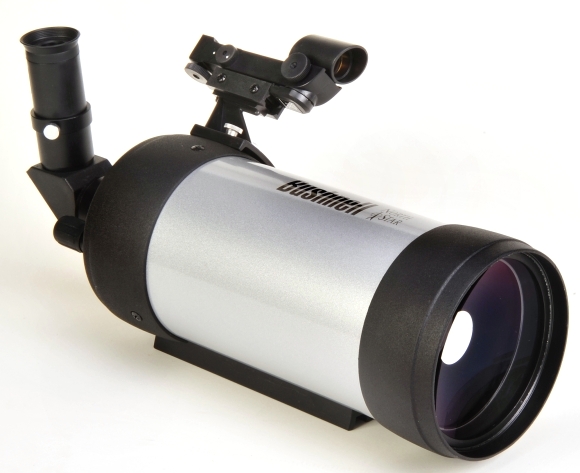
Before the telescope word jumble…
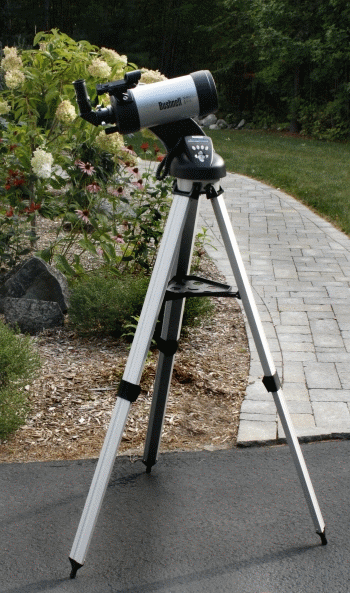 A telescope is one of those items that is nice to have around. They are a great alternative to TV, a basis for entertaining and educational family time and great for putting terrestrial life into proper perspective. The hurdle for fledging astronomers to overcome is having to accept that there is no such thing as a $49 telescope that would allow them to “get their feet wet”. Cheap telescopes will not produce a clear image and they will not permit any level of astronomical exploration. These types of telescopes end up in the garage buried under everything else that didn’t sustain a level of enthusiasm, and they unfairly cast astronomy in the same light.
A telescope is one of those items that is nice to have around. They are a great alternative to TV, a basis for entertaining and educational family time and great for putting terrestrial life into proper perspective. The hurdle for fledging astronomers to overcome is having to accept that there is no such thing as a $49 telescope that would allow them to “get their feet wet”. Cheap telescopes will not produce a clear image and they will not permit any level of astronomical exploration. These types of telescopes end up in the garage buried under everything else that didn’t sustain a level of enthusiasm, and they unfairly cast astronomy in the same light.
Investing a bit more to get a decent beginner’s telescope will assure the hardware has enough reach for the observer to explore developing interests; moving from planetary to deep space observation, learning astrophotography. The interest may even extend into social activities like traveling to sky parties, or the interest may develop as it has with my wife and I where we go outside in the evenings under the crisp, clear Maine sky and spend hours looking at the moon or Jupiter or any of the tens of thousands of astronomical bodies visible with a telescope like the Bushnell North Star 100mm Maksutov-Cassegrain.
Bushnell’s 100mm Maksutov-Cassegrain North Star telescope produces very bright sharp images, provides low to high magnification and incorporates a “Go To” computer that automatically locates and tracks over 20,000 astronomical objects. With an MSRP of $629, a little Internet shopping will find them selling for as little as $400 from reputable online retailers. The Bushnell North Star Cassegrain combines powerful features with simple controls so that even a novice like me can use it and it produces excellent imagery to keep night sky viewing interesting.
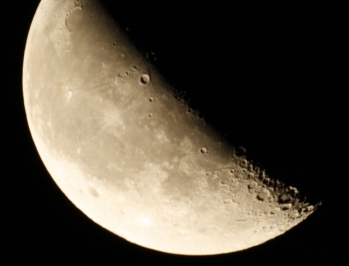 The basic North Star telescope includes the telescope, a sturdy tripod with computerized motor driven mount, two eyepieces that provide 52x or 325x magnification and a comprehensive operating manual. Only thirty minutes were required to read the product’s manual, assemble the telescope and subassemblies and get it outside and put to use observing.
The basic North Star telescope includes the telescope, a sturdy tripod with computerized motor driven mount, two eyepieces that provide 52x or 325x magnification and a comprehensive operating manual. Only thirty minutes were required to read the product’s manual, assemble the telescope and subassemblies and get it outside and put to use observing.
Within the capabilities of the North Star – Moon craters and other surface formations of less than three miles in scale can be seen – approximately eight times the magnification of this novice photo of the moon. Mercury can be observed in its various phases, Martian polar caps and contrasting surface colorations are visible, as are Jupiter’s cloud belts and moons. Saturn’s rings and a number of its moons can be seen, as can Uranus and Neptune, although the latter two appear as more non-descript disks of light; 1.6 billion miles can put a damper on detail visibility. Deep space viewing is also in the cards with clusters, nebulas, and galaxies with some visible detail and more to be captured than the eye can see through an eyepiece with a camera and time exposure using the North Star’s exploration software… Although Diane, my lovely wife, adamantly rejects my assertion that I saw the Enterprise. If you’ve ever had your assertion rejected, you know how painful an experience that can be.
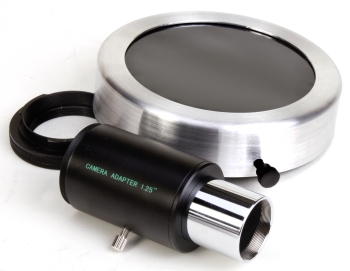
Beyond looking through a telescope, taking pictures through a telescope is also fun. With the addition of a camera adapter Bushnell offers as a $30 option, and a T Adapter that joins the adapter to a camera, less than $10, taking pictures is a snap. When photographing the sun, a solar filter, approx $36, is mandatory for both observer and telescope protection.
Time exposure and the Bushnell North Star’s computerized motor driven mount allow the camera to capture even faint deep space objects. The telescope’s kinetic mount keeps the astronomical object fixed in front of the camera lens to prevent motion blur, by moving in offset to the earth’s rotation.
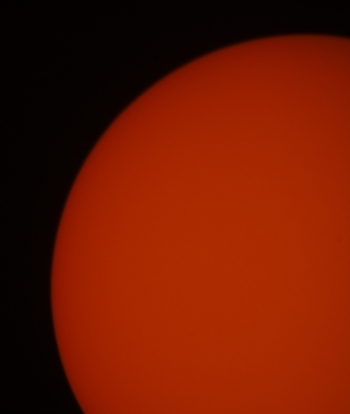 The Bushnell adapter supports both prime-focus photography, where the telescope acts as the camera’s lens, and eyepiece projection photography, where the camera captures the image as it appears magnified in the telescope’s eyepiece. The images appearing within this text were all shot as prime-focus. Magnification is equal to the focal length of the telescope divided by the diagonal of the sensor.
The Bushnell adapter supports both prime-focus photography, where the telescope acts as the camera’s lens, and eyepiece projection photography, where the camera captures the image as it appears magnified in the telescope’s eyepiece. The images appearing within this text were all shot as prime-focus. Magnification is equal to the focal length of the telescope divided by the diagonal of the sensor.
A basic Canon EOS XS was used to take these pictures. The camera’s sensor size is 22.2mm x 14.8mm which equates to a diagonal of 26.7mm. Dividing the telescope’s 1,300 mm focal length by 26.7mm results in a magnification of 48.6x. which yielded some decent results considering that level of magnification is below even the lowest power eyepiece supplied with the North Star. To further advance the effort I would work toward eyepiece selection and eyepiece projection photography.
No need to learn Windows or MAC….

The heart of the Bushnell North Star is its motorized computer controlled kinetic mount. Using the keypad, the operator does a quick setup and points the telescope at one identified star. Once this is accomplished, for as long as the North Star remains at the same location, entering a name or catalogue # for any of the 20,000 astronomical objects that appear in the telescope’s manual will result in the telescope finding that planet, star, cluster, nebula, etc. There is also a sky tour function that is run by the computer. Additionally, the observer can randomly move the telescope to any visible object in the sky, with the exception of airplanes, and the telescope will identify it by name and sky location.
I don’t know constellations or planets. They all looked like dots of light to me and I am really bad at celestial navigation. Consequently, initial computer setup required to set reference position for the telescope was a concern. Fortunately, the Internet is loaded with free sky map software resources. I was able to enter my town’s latitude and longitude (found it on the town’s web site) into the software, along with the then current date, and it spit out a detailed map of the night sky from every compass point in the horizon surrounding our home. With star map in hand, it took about 5 minutes identify a star, point the telescope to that point in the sky and let the telescope’s computer calibrate its own location. Then the telescope treated my wife and I to a tour of the visible universe. Pretty spiffy.
The North Star is for earthlings too…
Below photo set, the top photo was shot through the North Star mounted on a conventional camera tripod. The lower photo was take with a 300mm telephoto camera lens, both from the same spot in Casco, ME. The area in the lesser magnified camera lens image is circled in red. This was a prime-focus shot, but taken with a D700 Nikon where the sensor has a 43.2mm diagonal, which brought the magnification level down to 30x.
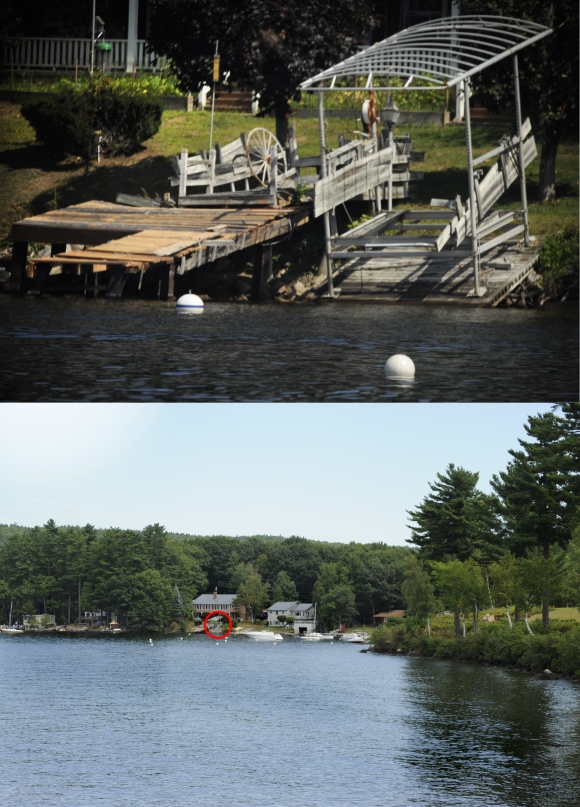
Bushnell’s North Star 100mm Maksutov-Cassegrain in greater detail…
I like to pick and poke at things to see how they work and the Bushnell Telescope proved to be an interesting piece of machinery and worth the exploration. This little further look allowed me to better understand the product’s theory of operation to see more of the telescope’s potential
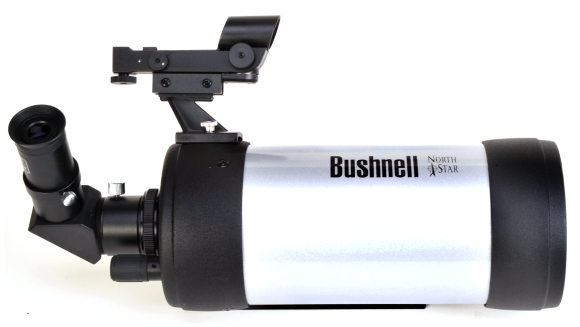
The 1,300mm focal length North Star main telescope body is only 11″ long. It fits this long focal length into a very compact package by folding a light path back and forth between lens and mirrors. As an example, an inline optical telescope, a rifle scope like refractor, would have to be approximately 52″ long to deliver the same focal length. In addition to its compact length, in the absence of multiple sets of heavy lens glass, Bushnell’s main telescope weighs only 5 lbs, , including a hefty mount base, or about 1/3rd the weight of a refractor telescope of similar capability.
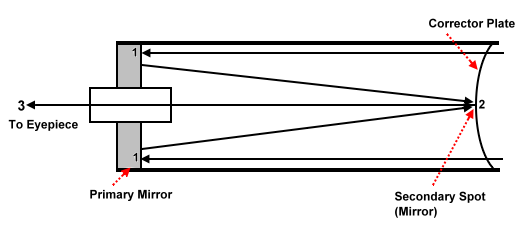
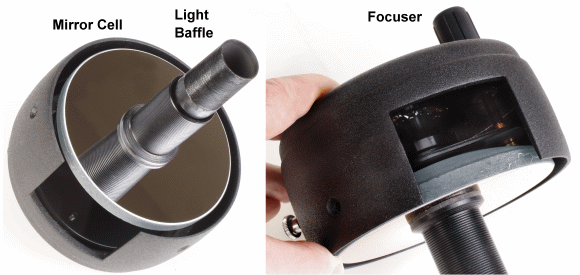
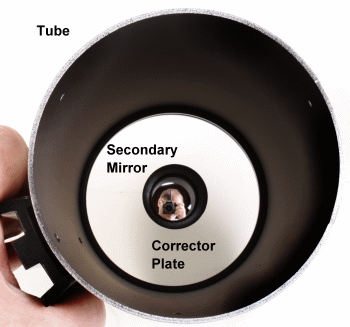 The North Star’s body is comprised of an 0.080″ thick, 4″ diameter aluminum tube, which makes for a solid structure. The corrector plate is clear against a white background. The concave secondary mirror is approximately 1″ in diameter. The guy in the middle of the secondary mirror is me… being just a little surreal. Unlike a Newtonian reflector the tube is closed to the elements and there is not spider leg like object holding the secondary mirror to obstruct light and vision.
The North Star’s body is comprised of an 0.080″ thick, 4″ diameter aluminum tube, which makes for a solid structure. The corrector plate is clear against a white background. The concave secondary mirror is approximately 1″ in diameter. The guy in the middle of the secondary mirror is me… being just a little surreal. Unlike a Newtonian reflector the tube is closed to the elements and there is not spider leg like object holding the secondary mirror to obstruct light and vision.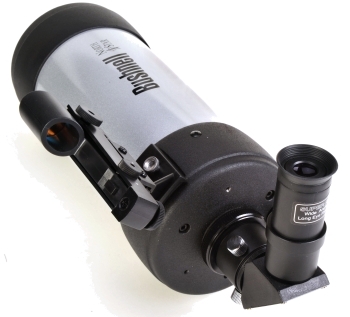 The North Star’s x100mm designation represents the diameter of the corrector plate. f ratio was calculated to be approximately f 13; focal length ÷ corrector plate diameter. The exit pupil, or size of the focused image for the two Bushnell supplied eyepieces, 4mm and 25mm, looked to be approximately 0.3mm and 1.9mm respectively. Telescope magnification is the quotient of the focal length of the telescope ÷ focal length of the eyepiece making the theoretical magnification with the two supplied eyepieces 52x and 325x. Don’t nod off on me yet, there is a point to all of this.
The North Star’s x100mm designation represents the diameter of the corrector plate. f ratio was calculated to be approximately f 13; focal length ÷ corrector plate diameter. The exit pupil, or size of the focused image for the two Bushnell supplied eyepieces, 4mm and 25mm, looked to be approximately 0.3mm and 1.9mm respectively. Telescope magnification is the quotient of the focal length of the telescope ÷ focal length of the eyepiece making the theoretical magnification with the two supplied eyepieces 52x and 325x. Don’t nod off on me yet, there is a point to all of this.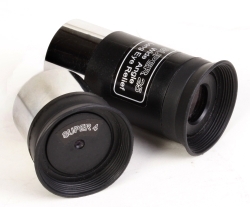 More to the point, the size of the exit pupil suggests that the two lens focal lengths that would bracket the North Star’s magnification range would be 65mm and 6.5mm for magnification of 20x and 200x respectively. Or I could have just stated the rule of thumb for a telescope’s magnification which is 50x per inch of aperture which in this case, at 100mm, would be 200x. Eyepieces to the amateur astronomer are like camera lenses to the photographer, each has a specific purpose and application. Bushnell included eyepieces to make the North Star useful and enjoyable right out of the box, however, and there many inexpensive 1.25″ eyepieces available from Bushnell and third party suppliers to further optimize the North Star.
More to the point, the size of the exit pupil suggests that the two lens focal lengths that would bracket the North Star’s magnification range would be 65mm and 6.5mm for magnification of 20x and 200x respectively. Or I could have just stated the rule of thumb for a telescope’s magnification which is 50x per inch of aperture which in this case, at 100mm, would be 200x. Eyepieces to the amateur astronomer are like camera lenses to the photographer, each has a specific purpose and application. Bushnell included eyepieces to make the North Star useful and enjoyable right out of the box, however, and there many inexpensive 1.25″ eyepieces available from Bushnell and third party suppliers to further optimize the North Star.
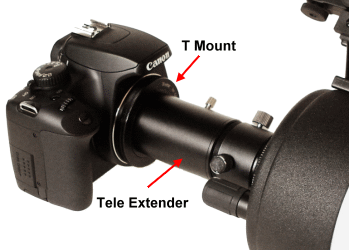 This is typical of prime focus and eyepiece projection photography with a Cassegrain. With eyepiece projection photography the eyepiece is removed from the diagonal and placed inside of the Tele Extender. A Cassegrain requires a longer tube than a refractor telescope to place the camera within range of focus.
This is typical of prime focus and eyepiece projection photography with a Cassegrain. With eyepiece projection photography the eyepiece is removed from the diagonal and placed inside of the Tele Extender. A Cassegrain requires a longer tube than a refractor telescope to place the camera within range of focus.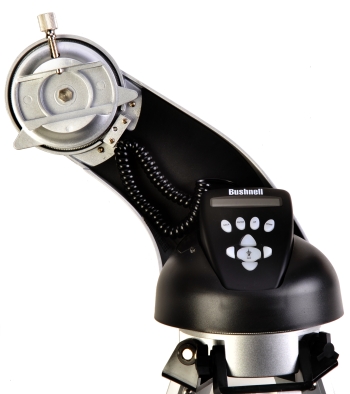

North Star 100mm Maksutov-Cassegrain conclusion…
Bushnell has been making high quality rifle and pistol scopes for an extended period of time. I believe this North Star just represents more of the same. It takes the complexity out of amateur astronomy and opens the door for a huge learning experience. My sentiments, as I bring this project to a close, is that I’m left with an interest in doing more sky exploration and developing some astrophotography skill. I began well over my head, now the water level has dropped low enough for me to feel assured my nose will remain surfaced. Considering Bushnell’s 100mm Maksutov-Cassegrain cost less than most moderately priced rifle scopes, the North Star represents a huge fun and educational return on investment. If I work really hard, I may eventually become a geek.

Email Notification